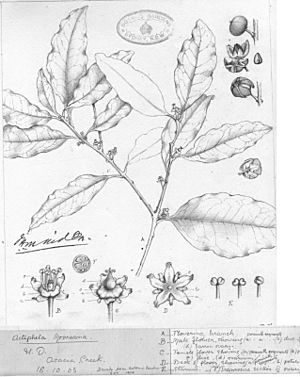Actephila lindleyi facts for kids
Quick facts for kids Actephila lindleyi |
|
|---|---|
 |
|
| drawing by Margaret Flockton | |
| Scientific classification | |
| Genus: |
Actephila
|
| Species: |
lindleyi
|
| Synonyms | |
Actephila lindleyi is a type of plant that belongs to the Phyllanthaceae family. It can grow as a shrub or a small tree, reaching up to 12 metres (about 40 feet) tall.
You can find this plant in warm, wet places called rainforests. It grows in coastal areas from the Shoalhaven River in New South Wales, Australia, all the way north to Papua New Guinea and nearby islands. In New South Wales, it grows on different kinds of soil, like those made from andesite (volcanic rock), basalt (another volcanic rock), or metamorphic rocks. It can be found from 40 to 500 metres (about 130 to 1,640 feet) above sea level. This plant is quite rare in the Illawarra region, which is at the southern edge of where it usually grows.
Contents
What Does Actephila lindleyi Look Like?
Trunk and Branches
The main stem, or trunk, of this plant is often bent or twisted. It is usually round, but sometimes it can have angles or wider parts at the bottom called buttresses. The bark is a dark reddish-black color and has small, raised spots called lenticels in lines.
The wood from this tree is good for making things on a lathe (a machine that shapes wood). This is because the wood is quite hard and has a fine grain. The smaller branches are thick, smooth, and brown, also with pale lenticels. You might also see marks on the branches where leaves used to be.
Leaves
The leaves grow one after another along the stem. They do not have jagged edges. Their shape is like a spearhead, sometimes a wide spearhead. The tip of each leaf is drawn out to a point.
The leaves are thick and shiny green on top, but a lighter green underneath. They are usually 7 to 18 centimetres (about 3 to 7 inches) long and 2.5 to 4 centimetres (about 1 to 1.5 inches) wide. The leaf stalks, which connect the leaf to the branch, are grooved on top and are 6 to 25 millimetres (about 0.2 to 1 inch) long. Only the main vein in the middle of the leaf stands out clearly. Other veins are not as easy to see, but they are slightly raised on both sides of the leaf. There are usually 6 to 10 side veins that are mostly straight but curve near the edge of the leaf.
Flowers and Fruit
Cream-colored flowers appear from the leaf corners (where the leaf meets the stem) between August and November. These flowers have very small petals.
After the flowers, the plant produces a red-brown fruit. This fruit is mostly round and has three distinct sections, like a small, three-lobed ball. The fruits ripen from April to September. Birds like the brown cuckoo-dove enjoy eating them. If you want to grow more of these plants, it's a good idea to use cuttings (pieces of the plant that can grow roots), as they grow easily. Fresh seeds can also sprout in 10 to 31 days, and about 80% of them will grow into new plants.
Plant Names and History
Scientists like Airy Shaw have studied different samples of Actephila lindleyi. They found that some plants once thought to be this species are now considered different types. For example, in New South Wales, some are now called A. grandifolia. In Queensland, others are known as A. flavescens, A. traceyi, A. venusta, and A. vernicosa.
The name Actephila comes from ancient Greek words. "Acte" means "sea shore," and "philos" means "fond." So, Actephila means "fond of the sea shore," which makes sense because the plant grows near coastal areas. The second part of the name, lindleyi, honors a botanist named John Lindley.
One of the older names for this plant was Actephila mooreana. The first sample of this plant used for scientific description was collected by Charles Moore near the Richmond River and Mount Lindesay in 1861. This plant was first written about in a science book called Nomenclator Botanicus in 1841. It was published by a German doctor named Ernst Gottlieb von Steudel.

